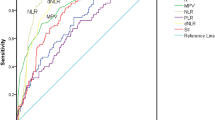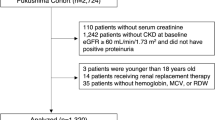Abstract
Background
Elevated white blood cell (WBC) count is a well-known predictor of chronic kidney disease (CKD) progression. However, elderly patients commonly fail to develop a high WBC count in response to several diseased states and may instead present a low WBC count. Therefore, we hypothesized that low WBC count, in addition to high WBC count, is associated with CKD progression in the elderly.
Methods
We conducted a prospective cohort study using 3-year follow-up data from the CKD Research of Outcomes in Treatment and Epidemiology study. In the present study, participants aged over 60 years with pre-dialysis CKD stages G2–G5 were eligible. Patients were stratified into three groups according to WBC count using tertiles (T). The primary outcome was a composite of end-stage renal disease and a 50% reduction in estimated glomerular filtration rate. Data were analyzed using Cox proportional hazard models with adjustments for covariates.
Results
We enrolled 697 patients (males, 69%). The median WBC count was 6100 cells/µl (T1, <5400, n = 222; T2, 5400–6900, n = 235; T3, ≥6900, n = 240). During a median follow-up of 868 days, the primary outcome was observed in 170 patients, whereas 54 patients died. T1 and T3 had significantly higher hazard ratios (HR) than T2 (T1, HR 1.69, 95% confidence interval 1.14–2.51; T3, HR 1.63, 95% confidence interval 1.10–2.41). Moreover, T1 had a significantly higher adjusted HR (1.54, 95% confidence interval 1.00–2.37).
Conclusion
Low WBC count is independently associated with CKD progression in the elderly.


Similar content being viewed by others
References
Kato S, Chmielewski M, Honda H, et al. Aspects of immune dysfunction in end-stage renal disease. Clin J Am Soc Nephrol. 2008;3:1526–33.
Kurts C, Panzer U, Anders HJ, et al. The immune system and kidney disease: basic and clinical implications. Nat Rev Immunol. 2013;13:738–53.
Wong G, Hayen A, Chapman JR, et al. Association of CKD and cancer risk in older people. J Am Soc Nephrol. 2009;20:1341–50.
Akchurin OM, Kaskel F. Update on inflammation in chronic kidney disease. Blood Purif. 2015;39:84–92.
Dalrymple LS, Go AS. Epidemiology of acute infections among patients with chronic kidney disease. Clin J Am Soc Nephrol. 2008;3:1487–93.
Silverstein DM. Inflammation in chronic kidney disease: role in the progression of renal and cardiovascular disease. Pediatr Nephrol. 2009;24:1445–52.
Kovesdy CP, George SM, Anderson JE, et al. Outcome predictability of biomarkers of protein-energy wasting and inflammation in moderate and advanced chronic kidney disease. Am J Clin Nutr. 2009;90:407–14.
Agarwal R, Light RP. Patterns and prognostic value of total and differential leukocyte count in chronic kidney disease. Clin J Am Soc Nephrol. 2011;6:1393–9.
Kim SM, Kim HW. Relative lymphocyte count as a marker of progression of chronic kidney disease. Int Urol Nephrol. 2014;46:1395–401.
Encarnacion MR, Beata BM, Kenneth D. Cause, consequences, and reversal of immune system aging. J Clin Investig. 2013;123:958–65.
Arai Y, Kanda E, Kikuchi H, et al. Decreased mobility after starting dialysis is an independent risk factor for short term mortality after initiation of dialysis. Nephrology (Carlton). 2014;19:227–33.
Weiskopf D, Weinberger B, Loebenstein GB. The aging of the immune system. Transplant Int. 2009;22:1041–50.
Lansdorp PM, Dragowska W, Thomas TE, et al. Age-related decline in proliferative potential of purified stem cell candidates. Blood Cells. 1994;20:376.
Hartsock RJ, Smith EB, Petty CS. Normal variations with aging of the amount of hematopoietic tissue in bone marrow from the anterior iliac crest. A study made from 177 cases of sudden death examined by necropsy. Am J Clin Pathol. 1965;43:326.
Iimori S, Noda Y, Okado T, et al. Baseline characteristics and prevalence of cardiovascular disease in newly visiting or referred chronic kidney disease patients to nephrology centers in Japan: a prospective cohort study. BMC Nephrol. 2013;14:152.
The Committee of Japan Diabetes Society on the Diagnostic Criteria of Diabetes Mellitus. Report of the committee on the classification and diagnostic criteria of diabetes mellitus. J Diabetes Investig. 2010;1:212–28.
The Committee of Japan Diabetes Society on the Diagnostic Criteria of Diabetes Mellitus. Report of the committee on the classification and diagnostic criteria of diabetes mellitus. Diabetol Int. 2010;1:2–20.
Matsuo S, Imai E, Horio M, et al. Revised equations for estimated GFR from serum creatinine in Japan. Am J Kidney Dis. 2009;53:982–92.
Chung S, Song HC, Shin SJ, et al. Relationship between erythropoietin resistance index and left ventricular mass and function and cardiovascular events in patients on chronic hemodialysis. Hemodial Int. 2012;16:181–7.
Kuwahara M, Arai Y, Takehara E, et al. Early response to erythropoiesis-stimulating agents in non-dialysis chronic kidney disease patients. Clin Exp Nephrol. 2016;20:585–94.
Kuwahara M, Mandai S, Kasagi Y, et al. Responsiveness to erythropoiesis-stimulating agents and renal survival in patients with chronic kidney disease. Clin Exp Nephrol. 2015;19:598–605.
Hsu CW, Lin JL, Lin-Tan DT, et al. White blood cell count predicts all-cause, cardiovascular disease-cause and infection-cause one-year mortality of maintenance hemodialysis patients. Ther Apher Dial. 2010;14:552–9.
Johnson DW, Wiggins KJ, Armstrong KA, et al. Elevated white cell count at commencement of peritoneal dialysis predicts overall and cardiac mortality. Kidney Int. 2005;67:738–43.
Reddan DN, Klassen PS, Szczech LA, et al. white blood cells as a novel mortality predictor in haemodialysis patients. Nephrol Dial Transplant. 2003;18:1167–73.
Anders HJ, Ryu M. Renal microenvironments and macrophage phenotype determine progression or resolution of renal inflammation and fibrosis. Kidney Int. 2011;80:915–25.
Cantu C, Proytcheva MA. Bone marrow failure syndromes, a practical approach to diagnosis. J Hematopathol. 2015;8:101–12.
Kang DH, Kanellis J, Hugo C, et al. Role of the microvascular endothelium in progressive renal disease. J Am Soc Nephrol. 2002;13:806–16.
Carney EF. Walking reduces inflammation in predialysis CKD. Nat Rev Nephrol. 2014;10:300.
Eikawa S, Nishida M, Mizukami S, et al. Immune-mediated antitumor effect by type 2 diabetes drug, metformin. Proc Natl Acad Sci USA. 2015;112:1809–14.
Bunt SK, Mohr AM, Bailey JM, et al. Rosiglitazone and Gemcitabine in combination reduces immune suppression and modulates T cell populations in pancreatic cancer. Cancer Immunol Immunother. 2013;62:225–36.
Feldman D, Krishnan AV, Swami S, et al. The role of vitamin D in reducing cancer risk and progression. Nat Rev Cancer. 2014;14:342–57.
Shen Y, Miao N, Xu J, et al. Metformin prevents renal fibrosis in mice with unilateral obstruction and inhibits Ang II-induced ECM production in renal fibroblasts. Int J Mol Sci. 2016;17:146. doi:10.3390/ijms17020146.
Kim MK, Ko SH, Baek KH, et al. Long-term effects of Rosiglitazone on the progressive decline in renal function in patients with type 2 diabetes. Korean J Intern Med. 2009;24:227–32.
Arai Y, Kanda E, Iimori S, et al. The use of vitamin D analogs is independently associated with the favorable renal prognosis in chronic kidney disease stages 4–5: the CKD-ROUTE study. Clin Exp Nephrol. 2017;21:481–7.
Papazova DA, Oosterhuis NR, Gremmels H, et al. Cell-based therapies for experimental chronic kidney disease: a systematic review and meta-analysis. Dis Model Mech. 2015;8:281–93.
Hickson LJ, Eirin A, Lerman LO. Challenges and opportunities for stem cell therapy in patients with chronic kidney disease. Kidney Int. 2016;89:767–78.
van Koppen A, Joles JA, Bongartz LG, et al. Healthy bone marrow cells reduce progression of kidney failure better than CKD bone marrow cells in rats with established chronic kidney disease. Cell Transplant. 2012;21:2299–312.
Author information
Authors and Affiliations
Corresponding author
Ethics declarations
Ethical approval
This study protocol was approved by the ethical review board of each institution. The approval numbers are listed below: Tokyo Medical and Dental University, school of medicine (No. 883); Tsuchiura Kyodo General Hospital (No. 212); Tokyo Metropolitan Tama Medical Center (No. 17); JA Toride Medical Center (No. 104); Ome Municipal General Hospital (No. 10); Tokyo Metropolitan Bokutoh Hospital (No. 20); Tokyo Metropolitan Otsuka Hospital (No. 2010-15); Clinical Research Center, Chiba-East National Hospital (No. 15). The research was performed in accordance with the ethical principles of the Declaration of Helsinki. The protocol was registered in the University Hospital Medical Information Network (UMIN) Clinical Trials Registry (UMIN000004461).
Informed consent
Written informed consent was obtained from all individual participants included in the study.
Conflict of interest
The authors declare that no conflicts of interest exist.
Electronic supplementary material
Below is the link to the electronic supplementary material.
About this article
Cite this article
Arai, Y., Kanda, E., Iimori, S. et al. Low white blood cell count is independently associated with chronic kidney disease progression in the elderly: the CKD-ROUTE study. Clin Exp Nephrol 22, 291–298 (2018). https://doi.org/10.1007/s10157-017-1441-6
Received:
Accepted:
Published:
Issue Date:
DOI: https://doi.org/10.1007/s10157-017-1441-6




